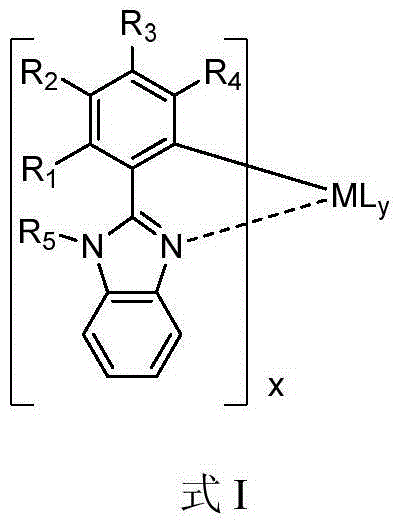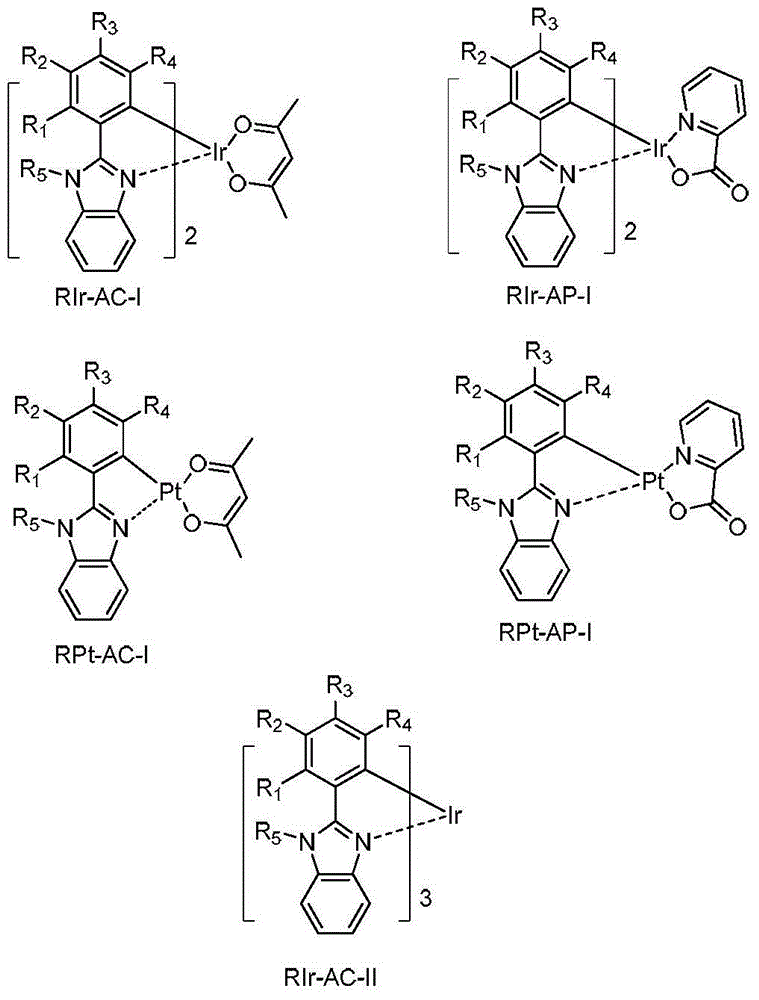Liquid crystal modified carbazole derivative organic electrophosphorescent materials as well as preparation method and application thereof
A reaction and compound technology, applied in the field of carbazole derivative organic electrophosphorescent materials and its preparation, can solve the problems of lack of stability and efficiency
- Summary
- Abstract
- Description
- Claims
- Application Information
AI Technical Summary
Problems solved by technology
Method used
Image
Examples
Embodiment 1
[0127] Embodiment 1, the preparation of compound RIr-AC-I-001 (method one)
[0128]
[0129] The acetylacetone of the compound G-2 of 1.406g (1mmol) and 192mg (2mmol) and the anhydrous sodium carbonate of 1.038g (10mmol) are dispersed in the acetonitrile of 80ml and the chloroform of 80ml, under the protection of nitrogen, temperature rises and refluxes and carries out substitution reaction After 24 hours, cool to room temperature, pour the reaction solution into water, extract with DCM, dry the organic phase, filter, and concentrate the filtrate to dryness under reduced pressure. The residue is separated and purified by silica gel column to obtain 650 mg of compound RIr-AC-I-001, yellow solid;
[0130] Experimental data:
[0131] (1) 1HNMR (δ, C2D6SO): 0.8~1.0(23H,m); 1.0~1.3(10H,m); 1.3~1.7(15H,d); 1.7~2.0(7H,m); 3.2~3.5( 6H,m); 5.2~5.5(1H,m); 6.0~6.2(2H,q); 6.2~6.5(4H,t); 7.0~7.2(2H,t); 7.2~7.8(15H,m). It is confirmed that the substance obtained by the reaction is ind...
Embodiment 2
[0136] Embodiment 2, the preparation of compound RIr-AC-II-001 (method three)
[0137]
[0138] Stir and disperse 1.4g of the compound shown in G-2 and 4.76g of the compound shown in G-1 with 80ml of glycerin. Under nitrogen protection, heat up to 180°C, stir and reflux for substitution reaction for 8 hours, cool to room temperature, and dissolve the reaction solution Pour into 200ml of 1M dilute hydrochloric acid, suction filter, wash the filter cake with water, separate and purify the obtained solid with silica gel column to obtain 0.84g of RIr-AC-I-001 as a white solid.
[0139] Experimental data:
[0140] (1) 1HNMR (δ, C2D6SO): 0.8~1.0(35H,m); 1.0~1.3(15H,m); 1.3~1.7(21H,d); 1.7~2.0(11H,m); 6.0~6.2( 5H,q); 6.2~6.5(7H,t); 7.0~7.2(3H,t); 7.2~7.8(20H,m). It is confirmed that the substance obtained by the reaction is indeed the compound RIr-AC-II-001;
[0141] (2) Glass transition temperature (DSC): 264.3°C;
[0142] (3) UV maximum absorption wavelength (DCM): 256nm, 31...
Embodiment 3
[0145] Embodiment 3, the preparation of compound RIr-AP-I-001 (method two)
[0146]
[0147] 2.8g of compound G-2 and 707mg of 2-pyridinecarboxylic acid, 324mg of anhydrous potassium carbonate and 50ml of 1,4-dioxane were heated and refluxed to carry out the substitution reaction for 8 hours, concentrated to dryness under reduced pressure, and the residue was washed with silica gel Column separation and purification yielded 1.4 g of compound RIr-AP-I-001 as a yellow solid.
[0148] Experimental data:
[0149] (1) 1HNMR (δ, C2D6SO): 0.8~1.0(23H,m); 1.0~1.3(10H,m); 1.3~1.7(15H,d); 1.7~2.0(7H,m); 3.2~3.5( 6H,m); 5.2~5.5(2H,m); 6.0~6.2(3H,q); 6.2~6.5(5H,t); 6.6~6.8(2H,m)7.0~7.2(3H,t); 7.2 ~7.8(17H,m). It is confirmed that the substance obtained by the reaction is indeed the compound RIr-AP-I-001;
[0150] (2) Glass transition temperature (DSC): 268.6°C;
[0151] (3) UV maximum absorption wavelength (DCM): 258nm, 307nm, 324nm;
[0152] (4) Phosphorescence emission waveleng...
PUM
| Property | Measurement | Unit |
|---|---|---|
| Phosphorescence emission wavelength | aaaaa | aaaaa |
| Phosphorescence emission wavelength | aaaaa | aaaaa |
| Phosphorescence emission wavelength | aaaaa | aaaaa |
Abstract
Description
Claims
Application Information
 Login to View More
Login to View More - R&D Engineer
- R&D Manager
- IP Professional
- Industry Leading Data Capabilities
- Powerful AI technology
- Patent DNA Extraction
Browse by: Latest US Patents, China's latest patents, Technical Efficacy Thesaurus, Application Domain, Technology Topic, Popular Technical Reports.
© 2024 PatSnap. All rights reserved.Legal|Privacy policy|Modern Slavery Act Transparency Statement|Sitemap|About US| Contact US: help@patsnap.com










